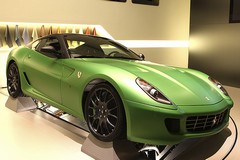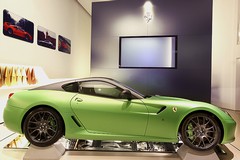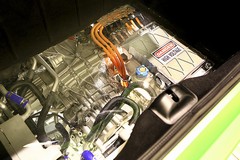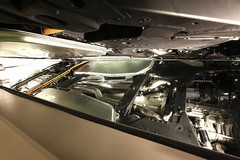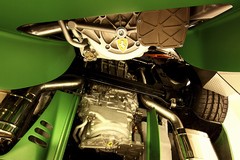Geneva Special: Ferrari's Hybrid Future
Under the skin of the Ferrari 599 hybrid 'rolling laboratory'
Deep within the bowels of Ferrari's Maranello HQ lie the two most powerful engines Ferrari has ever produced. Each one runs on gas, has 20 cylinders, a total swept capacity of 769 litres, runs at 750rpm and produces as much power as 37 Ferrari 599s. They are also among the most efficient engines in the world.
These two behemoths, painted in a very Ferrari red, form the twin beating hearts of Ferrari's 'Trigeneration' plant. This is essentially Ferrari's very own power station, a super-efficient, state-of-the-art facility that produces power, hot water and 'super-heated' water for the whole factory.
I mention the Trigeneration engines as proof that being environmentally friendly doesn't need to mean being dull or underpowered. Because as well as being as green as an internal combustion engine can be, they are also thunderous, intoxicating and awesomely powerful.
Which brings us to the car you see in these pictures. Despite looking almost every inch an ordinary 599, this is a hybrid concept - Ferrari's first - and, much like those two 20-cylinder powerhouses, it doesn't want for power or performance.
But don't expect to walk into a Ferrari dealership in 12 months' time to find a showroom full of green petrol-electric cars - the folks at Maranello are firm about the car's concept status and describe Kermit the Ferrari as a 'rolling laboratory' for future technology.
Ferrari's engineers won't be pinned down to exact timescales, but say that we won't be able to by a Ferrari like this for 'at least three years'. Eventually, though, you will be able to buy a car with some - if not all - the hybrid 599's technical innovations.
Ferrari has arrived at hybrid technology almost reluctantly, with the creeping realisation that, however hard its engineers try, they won't be able to bring the efficiency gains required to meet ever more stringent emissions regulations without radical changes to the way a Ferrari produces its power.
To put the scale of the problem into context, the current Ferrari range's average CO2 output is 305g/km. That needs to be more than halved to 140g/km by 2012 (although the fact that a production hybrid Ferrari is more than three years away does rather suggest that this particular target won't be met even in a best-case scenario). Getting this achieved solely by clever weight saving tricks, lower and lower rolling resistance tyres, tricky transmissions and super-slippery shapes (all of which Ferrari is working on) is nigh-on impossible.
There are also plenty of tricks you can make an internal combustion engine perform to improve its efficiency, and so Ferrari is trying all of those, too. Stop-start is one (and arrives on the California very soon), minimising the friction of an engine's internals is another, and cylinder deactivation (running on just four, six or eight cylinders when possible) is yet another. It's an impressive suite of technologies, but even that is not enough. Hence the move to a hybrid powertrain.
Creating a hybrid Ferrari is not a simple case of bunging on an electric motor and hoping for the best, however. Ferrari is hard at work developing a hybrid drivetrain that can be adapted to either its front-engined V12 models or its mid-engined V8 cars with minimal fuss via a dual-clutch gearbox (not yet available on the 'ordinary' 599 but already present in the 458 and California). It has also developed its own entirely bespoke electric motor - one that does the work of both alternator and starter motor. A chucked-together backroom project this is not.
This is also not a project that will result in a compromised driving experience. If anything the reverse ought to be true, as Ferrari has pledged to at least maintain - if not improve - the car's power to weight ratio. In simple numeric terms this means that the electric motor will add around 100bhp and 110lb ft of torque, while costing no more than 100kg in weight.
As well as improving fuel economy, the electric motor will also provide a 'boost' to performance (think KERS in Formula One), while any weight gains should be offset by weight-saving measures. This includes some stuff as simple as getting rid of the now-redundant alternator and conventional battery (regenerative braking helps keep the electric motor charged and that powers the car's ancillary electric systems.
Ferrari is also at pains to point out that the exterior and interior packaging of the 599 is not affected, nor do any of the hybrid gubbins affect the aerodynamics. What does change is the centre of gravity. It's actually lower than the 480mm centre of gravity in a conventionally engined 599 courtesy of super-slim lithium ion battery cells below the seats (less than 20mm thick) and the generally low-slung positioning of the electric motor.
As its super-efficient power-generation engines show, Ferrari is taking green engineering very seriously, but as the 599 hybrid concept appears to reveal, it is doing so to make sure its cars remain every bit as exhilarating - and fast - as they always have been.
Gassing Station | General Gassing | Top of Page | What's New | My Stuff


